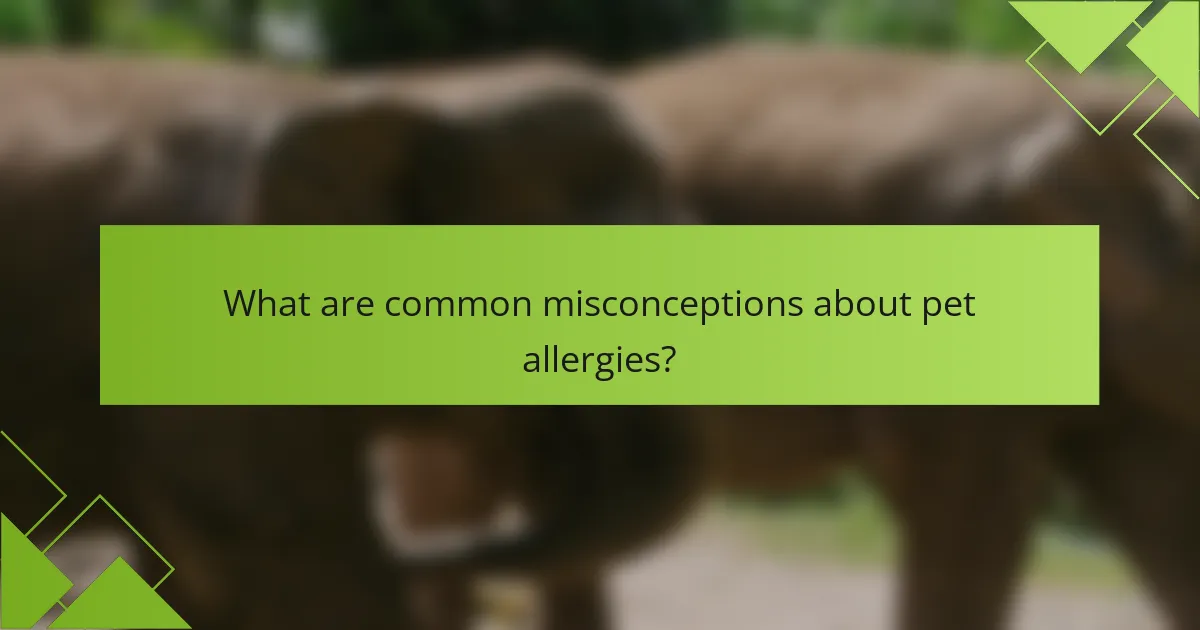Pet allergies can significantly impact quality of life, causing symptoms like sneezing and respiratory issues. Understanding common allergens, recognizing symptoms, and exploring effective management strategies are essential steps in addressing this challenge. Diagnosis methods and lifestyle adjustments can help reduce exposure and alleviate discomfort. Additionally, awareness of regional and cultural factors can inform tailored approaches for better management.

What causes pet allergies?
Pet allergies are primarily caused by proteins found in pet saliva, urine, and dander. These allergens can trigger immune responses in sensitive individuals, leading to symptoms like sneezing, itching, and respiratory issues. Common pets associated with allergies include cats and dogs. Managing pet allergies often involves minimizing exposure, using air purifiers, and considering hypoallergenic breeds. Regular cleaning and grooming can also help reduce allergen levels in the home.
How do pet allergens affect human health?
Pet allergens can significantly impact human health, leading to symptoms like sneezing, itching, and respiratory issues. Exposure to pet dander, saliva, and urine can trigger allergic reactions in sensitive individuals. These allergens can exacerbate conditions such as asthma and lead to chronic respiratory problems.
Managing pet allergies involves minimizing exposure through regular cleaning, using air purifiers, and maintaining a pet-free zone in the home. For those with severe reactions, consulting an allergist for potential treatments, such as immunotherapy, may be beneficial. Understanding these aspects helps individuals mitigate health risks associated with pet allergens.
Which pets are most commonly associated with allergies?
Cats, dogs, and rabbits are the most commonly associated pets with allergies. Pet allergens primarily come from dander, saliva, and urine, causing reactions in sensitive individuals. Cats tend to produce more allergens than dogs, making them a significant concern. Additionally, certain dog breeds, such as Poodles and Bichon Frises, are often recommended for allergy sufferers due to their lower dander levels. Understanding these associations helps in managing pet allergies effectively.

What are the symptoms of pet allergies?
Common symptoms of pet allergies include sneezing, runny or stuffy nose, itchy eyes, and skin rashes. Some individuals may also experience coughing, wheezing, or difficulty breathing. These symptoms arise from the body’s immune response to allergens found in pet dander, saliva, or urine. Identifying and managing these symptoms is crucial for improving quality of life for allergy sufferers.
How do symptoms vary by individual?
Symptoms of pet allergies vary significantly among individuals due to genetic and environmental factors. Some may experience mild symptoms like sneezing, while others may suffer severe reactions, including asthma attacks. The specific pet involved can also influence symptom severity; for instance, cat allergens tend to provoke stronger reactions than dog allergens. Additionally, exposure duration and frequency can exacerbate or alleviate symptoms, making personal experiences unique.
What are the most common allergic reactions to pets?
Common allergic reactions to pets include sneezing, itching, rashes, and respiratory issues. These reactions often stem from proteins found in pet saliva, urine, and dander. Individuals may experience symptoms like nasal congestion or asthma attacks. Management strategies include minimizing exposure, using air purifiers, and considering hypoallergenic breeds.

How can pet allergies be diagnosed?
Pet allergies can be diagnosed through a combination of medical history, physical examinations, and specific allergy tests. A veterinarian may conduct skin tests or blood tests to identify allergens. These tests help determine the specific pet dander or other environmental factors causing allergic reactions.
What tests are used to identify pet allergies?
Skin tests and blood tests are commonly used to identify pet allergies. Skin tests involve applying allergens to the skin and observing reactions, while blood tests measure specific antibodies. Both methods help determine sensitivities to various pet dander, saliva, and urine. Skin tests typically provide quicker results, whereas blood tests are less invasive.
How do healthcare professionals interpret allergy test results?
Healthcare professionals interpret allergy test results by analyzing specific markers that indicate sensitivity to allergens. They consider the type of test, such as skin prick or blood tests, and evaluate the levels of IgE antibodies associated with pet allergens. Elevated IgE levels suggest an allergic reaction, while negative results may indicate tolerance.
Additionally, professionals assess the patient’s history and symptoms to correlate test results with clinical presentations. This holistic approach ensures accurate diagnosis and effective management strategies for pet allergies.

What management strategies are effective for pet allergies?
Effective management strategies for pet allergies include minimizing exposure, using air purifiers, and medication. Regular cleaning reduces allergens in the home environment. Consider hypoallergenic pet breeds as a long-term solution. Immunotherapy may also provide relief for persistent cases.
How can environmental changes reduce allergen exposure?
Environmental changes can significantly reduce allergen exposure by altering habitats and minimizing allergen production. For instance, controlling humidity can limit mold growth, while reducing air pollution can decrease pollen levels. Additionally, urban planning that incorporates green spaces can help filter air pollutants and allergens. As a result, these strategies promote healthier environments and improve allergy management for affected individuals.
What role do medications play in managing pet allergies?
Medications play a crucial role in managing pet allergies by alleviating symptoms and improving quality of life. Antihistamines, corticosteroids, and immunotherapy are commonly prescribed to reduce itching, inflammation, and allergic reactions. Antihistamines provide quick relief from itching, while corticosteroids address more severe symptoms by reducing inflammation. Immunotherapy, including allergy shots, gradually desensitizes pets to allergens, offering long-term solutions. Regular veterinary consultations ensure optimal medication management tailored to each pet’s unique allergy profile.
How can immunotherapy help with pet allergies?
Immunotherapy can significantly reduce pet allergy symptoms by desensitizing the immune system. This treatment involves administering gradual doses of allergens, helping pets build tolerance over time. Studies indicate that immunotherapy can lead to long-lasting relief, even after treatment ends. Additionally, it may minimize the need for medications, improving overall quality of life for allergic pets.

What are some lifestyle adjustments for pet allergy sufferers?
Pet allergy sufferers can manage their symptoms with several lifestyle adjustments. Regular cleaning reduces allergens by removing pet dander and hair. Using air purifiers with HEPA filters helps trap airborne allergens. Designating pet-free zones, especially in bedrooms, minimizes exposure. Additionally, frequent hand washing after pet interactions can prevent allergen transfer. Bathing pets weekly can further decrease dander levels.
How can pet owners maintain a pet-friendly home while managing allergies?
Pet owners can maintain a pet-friendly home while managing allergies by implementing effective cleaning and care strategies. Regularly vacuuming with HEPA filters reduces dander and allergens. Designating pet-free zones, such as bedrooms, minimizes exposure. Using air purifiers improves air quality by filtering out allergens. Regular grooming and bathing of pets decrease fur and dander in the home. Lastly, consulting with an allergist can provide personalized management plans tailored to individual sensitivities.
What are the best practices for cleaning and reducing allergens?
To effectively clean and reduce allergens related to pet allergies, focus on regular cleaning and specific methods. Vacuum carpets and upholstery frequently using a HEPA filter. Wash pet bedding and toys weekly in hot water to eliminate dander. Use air purifiers to capture airborne allergens. Regularly groom pets to minimize shedding and dander. Consider using allergen-proof covers on pillows and mattresses.

How do pet allergies differ across regions and cultures?
Pet allergies can vary significantly across regions and cultures due to environmental factors, genetic predispositions, and pet ownership practices. For instance, urban areas may have higher allergy rates due to increased exposure to allergens, while rural regions might show different patterns influenced by local flora and fauna.
Cultural attitudes towards pets also affect allergy prevalence. In cultures where pets are considered family members, exposure may lead to higher sensitization rates. Conversely, cultures with less interaction with pets may report lower allergy incidences.
Additionally, the types of pets commonly kept differ by region, impacting the specific allergens present. For example, cat allergies may be more prevalent in areas with high cat ownership.
Understanding these regional and cultural differences is essential for effective management strategies tailored to specific populations.
What unique challenges do pet allergy sufferers face in urban environments?
Pet allergy sufferers in urban environments face heightened exposure to allergens and limited control over their surroundings. Factors such as increased pet ownership density, airborne pollutants, and confined living spaces exacerbate symptoms. Urban dwellers may struggle to find pet-free zones, making it challenging to manage their allergies effectively. Additionally, public spaces often have pet allergens, complicating outdoor activities.
How do pet ownership trends impact allergy prevalence in different areas?
Pet ownership trends can significantly influence allergy prevalence in various regions. Increased pet ownership often correlates with higher levels of pet dander, which can exacerbate allergy symptoms in sensitive individuals. Urban areas with dense populations may see different allergy patterns compared to rural regions, largely due to varying pet ownership rates and environmental factors. For instance, cities with high pet ownership might report increased cases of asthma and allergic rhinitis linked to pet allergens. Conversely, areas with lower pet ownership may experience fewer allergy cases, highlighting the impact of pet presence on overall allergy prevalence.

What are common misconceptions about pet allergies?
Many people mistakenly believe that pet allergies are only caused by fur. In reality, allergens can also come from dander, saliva, and urine. Another common misconception is that hypoallergenic pets do not cause allergies, but they can still produce allergens. Additionally, some assume that pet allergies only develop in childhood, while they can occur at any age. Lastly, many think that removing a pet will completely eliminate their allergy symptoms, but environmental factors may still trigger reactions.
How do myths about pet allergies affect treatment choices?
Myths about pet allergies can lead to ineffective treatment choices, causing unnecessary suffering. Many people believe that all pets cause allergies, which can result in avoiding beneficial companionship. Misunderstandings about hypoallergenic breeds may also misguide pet selection. This can limit options for individuals seeking emotional support or companionship from animals. Proper education on the specific allergens and effective management strategies can enhance treatment outcomes and improve quality of life for allergy sufferers.
What is the truth behind hypoallergenic pet breeds?
Hypoallergenic pet breeds are not completely allergy-free, but they may produce fewer allergens. Individuals with pet allergies often react to proteins found in pet saliva, urine, and skin. Breeds like Poodles and Bichon Frises are known for lower shedding, which can help reduce allergen spread. Regular grooming and cleaning can further manage allergy symptoms.

What expert tips can help manage pet allergies effectively?
To manage pet allergies effectively, consider these expert tips. Regular cleaning reduces allergens in your home. Use air purifiers to filter out pet dander. Designate pet-free zones, especially in bedrooms, to minimize exposure. Regular grooming and bathing of pets can also help decrease allergen levels. Lastly, consult with an allergist for personalized management strategies.
Which common mistakes should be avoided in managing pet allergies?
To manage pet allergies effectively, avoid common mistakes such as neglecting regular cleaning, failing to identify specific allergens, and not consulting a veterinarian. These errors can exacerbate symptoms and hinder effective management.
Regular cleaning of pet areas reduces allergen accumulation, while identifying specific allergens helps tailor management strategies. Consulting a veterinarian ensures proper diagnosis and treatment plans, enhancing overall allergy management.
How can pet allergy sufferers find support and resources?
Pet allergy sufferers can find support and resources through various channels. Local allergy support groups offer community and shared experiences. Online forums and social media networks provide access to information and personal stories. Medical professionals can recommend specific resources and treatment options. Educational websites and organizations focused on allergies offer valuable insights and tips for managing symptoms effectively.
